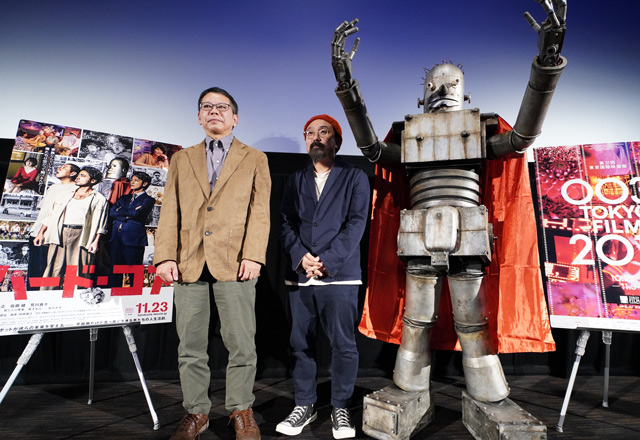
Appearing in a Dracula cape to mark Halloween, Roboo raised his silver arms stiffly and made that familiar beckoning gesture with his many fingers — and the flashbulbs went into frenzy mode after the world premiere of his film HARD-CORE, which played in the 31st TIFF Special Screenings section.
The giant robot had just joined his director, Nobuhiro Yamashita, and the author of the manga on which the film is based, Takashi Imashiro, following their Q&A session on October 31.
Yamashita’s film stars Takayuki Yamada, Takeru Satoh, Yoshiyoshi Arakawa and Roboo in a touching but mirthful drama about loneliness, lust, friendship and doing the right thing.
Sad-sack Ukon Gondo (Yamada) has no people skills whatsoever, and ekes out a living doing odd jobs. His only friend is Ushiyama (Arakawa), a perpetual adolescent who lives in an abandoned factory. They’re hired by an old geezer who’s intent on finding Edo-era gold that’s been buried deep in the mountains of Gunma Prefecture, so he can use it to restore Japan’s Imperial honor. One day, Ukon and Ushiyama find a rusty old robot at the abandoned factory, and when Ukon’s tech-savvy younger brother comes to visit, he has a look. Sakon (Takeru Satoh) works at a trading company and knows his gadgetry. In no time at all, he’s rejiggered the robot and brought him back to life.
The best friends name him Roboo, rustle up some XXL-sized clothing for him, and take him to work. It turns out that Roboo is perfectly cut out for gold-mining, and the work goes much more quickly. Celebrating one night at a bar, the three pals run into some tough guys, and it’s only when they start beating up on the boys that Roboo’s true talents emerge, in a flash of blinding light.
Yamashita came to international attention with his high school girl-band film Linda Linda Linda in 2005; he has since maintained a steadfast focus on small-town dreamers, doers and losers, although his 2011 My Back Page strayed into more political territory. HARD-CORE is his first sci-fi tinged tale, but it seems tailor-made for the director’s love of oddballs and gentle eccentricities.
The film is based on the manga series “Hard-Core Heisei Hell’s Bros.,” a collaboration between Caribu Marley and Takashi Imashiro that ran from 1991-1993, and is not yet translated into English. As the author admitted during the Q&A session, “We always thought it would be too difficult to make into a live film, because the first and second parts of the manga are so different in terms of story. It seemed like a very risky thing to do.”
Asked what the biggest challenges were, Yamashita noted that, “Roboo’s suit didn’t arrive until the first day of shooting. Since it was so last minute, we didn’t have any rehearsal in it. That was difficult.”
He went on, “I’ve made films out of several manga already and each time it’s a different experience. Since I read this when I was young and liked it so much — and this was the first time I was making something I liked so much — I had to take a step back from those feelings. I decided I wanted to make the film essentially as the manga was written.”
He recalled that Yamada, a frequent collaborator of the director’s, “was also a great fan of the story. We started talking about working together on it five years ago, so it’s taken a long time.”
Yamada also produced the film, which is an unusual step for an actor to take. “He liked the original story so much,” explained the director, “and I thought he would be the type of producer who would protect the original story because of that. He was quite particular about who we cast.”
Famous for his public (and surely scripted) disputes with the actor on the popular TV series “Takayuki Yamada’s Tokyo Akabane,” he was asked whether they’d also quarreled on this film. “This time I was the director and he was the main character, whereas with “Akabane,” that wasn’t the case. We had a lot of disagreements, but this time it was fine. We respected each other and exchanged opinions, but not to the point of disagreement.”
On directing with Yamada and mega-star Satoh, he said, “I didn’t give them any direction, I just explained, ‘This is what I want to do, and what I’m thinking.’ Before we started shooting, I explained everything and they prepared. If it was completely different from what I expected, I corrected them.”
Asked why he’d cast Satoh in a role so different from his typical character, Yamashita explained, “I actually thought that he was very close to the character in the story. Since he’s worked with Mr. Yamada in the past and they have good chemistry, I thought they’d be good together as brothers. Mr. Satoh usually plays the main role, but nevertheless he seemed to enjoy himself.
The emcee asked Imashiro about working with his collaborator on the manga, and unexpectedly, the session took a more somber turn. “I met Marley Caribu 25 years ago and he died at the beginning of this year,” Imashiro recalled. “If he hadn’t asked me to work with him, this manga would not have been realized and we wouldn’t have this film. He was like a mentor to me, and he loved film. But he didn’t have the chance to see this.”
Yamashita added, “He died just before we finished the film, which is very unfortunate. I was really touched by HARD-CORE when I was in my 20s, and if I’d had a chance, I would have liked to ask him about the things I still don’t understand about the story.”
“He didn’t like to explain things logically,” explained Imashiro. “He worked instinctually. If there are parts of the story you don’t understand, I would say that’s a good reflection of his character.”